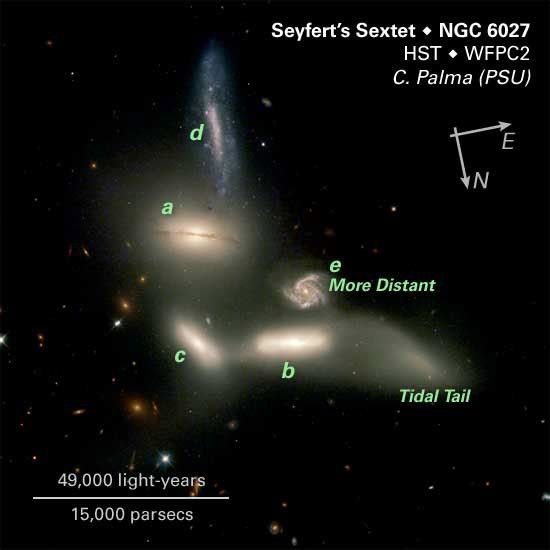1 min read
Seyfert’s Sextet, Annotated Image

About the Object
- R.A. PositionR.A. PositionRight ascension – analogous to longitude – is one component of an object's position.15h 59m 12.0s
- Dec. PositionDec. PositionDeclination – analogous to latitude – is one component of an object's position.20° 45' 29.99"
- ConstellationConstellationOne of 88 recognized regions of the celestial sphere in which the object appears.Serpens
- DistanceDistanceThe physical distance from Earth to the astronomical object. Distances within our solar system are usually measured in Astronomical Units (AU). Distances between stars are usually measured in light-years. Interstellar distances can also be measured in parsecs.190 million light-years (58 megaparsecs)
- DimensionsDimensionsThe physical size of the object or the apparent angle it subtends on the sky.This image is roughly 2.1 arcminutes (35 kpc or 114,000 light-years) in the vertical direction.
About the Data
- Data DescriptionData DescriptionProposal: A description of the observations, their scientific justification, and the links to the data available in the science archive.
Science Team: The astronomers who planned the observations and analyzed the data. "PI" refers to the Principal Investigator.Principal Astronomers: C. Palma, S. G. Zonak, S. Hunsberger, J. Charlton, S. C. Gallagher, P. Durrell (PSU), and J. English (U. Manitoba) - InstrumentInstrumentThe science instrument used to produce the data.HST>WFPC2
- Exposure DatesExposure DatesThe date(s) that the telescope made its observations and the total exposure time.June 26, 2000, Exposure Time: 4.1 hours
- FiltersFiltersThe camera filters that were used in the science observations.F336W (U), F439W (U), F555W (V), and F814W (I)
- Object NameObject NameA name or catalog number that astronomers use to identify an astronomical object.Seyfert's Sextet, HCG 79, NGC 6027
- Object DescriptionObject DescriptionThe type of astronomical object.Galaxy Group
- Release DateDecember 12, 2002
- Science ReleaseHubble Watches Galaxies Engage in Dance of Destruction
- Credit

Compass and Scale
Compass and ScaleAn astronomical image with a scale that shows how large an object is on the sky, a compass that shows how the object is oriented on the sky, and the filters with which the image was made.
Related Images & Videos

Seyfert's Sextet: Four Colliding Galaxies, and Two Bystanders
NASA's Hubble Space Telescope is witnessing a grouping of galaxies engaging in a slow dance of destruction that will last for billions of years. The galaxies are so tightly packed together that gravitational forces are beginning to rip stars from them and distort their shapes....
Share
Details
Last Updated
Aug 17, 2025
Contact
Media
Claire Andreoli
NASA’s Goddard Space Flight Center
Greenbelt, Maryland
claire.andreoli@nasa.gov




























